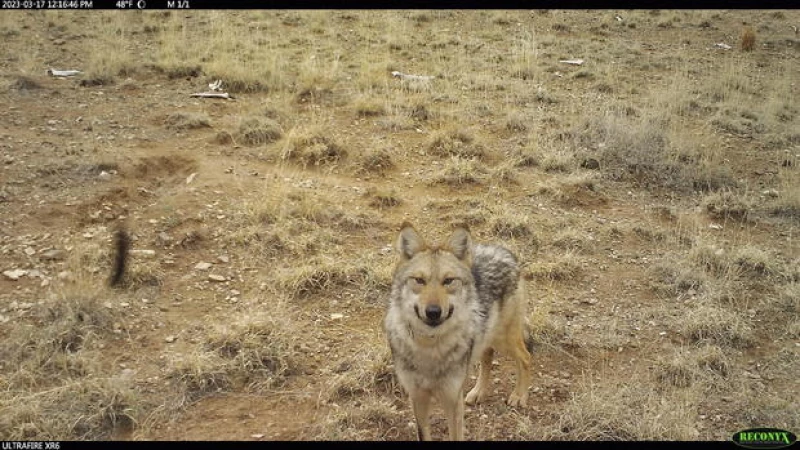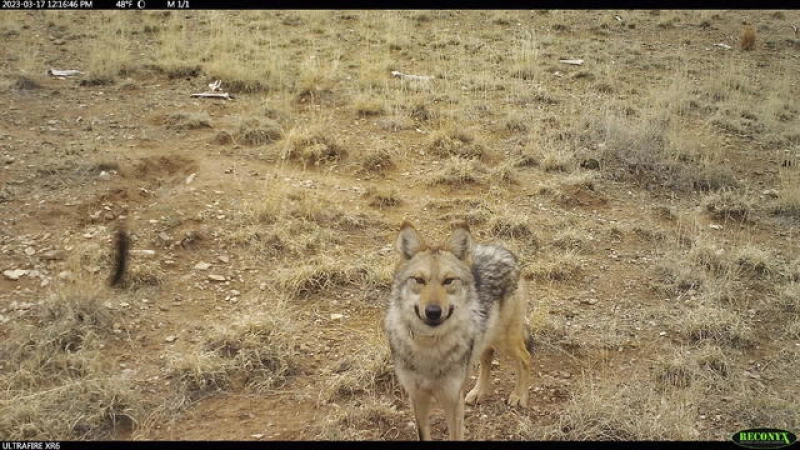A match made in the wilds of New Mexico?
An endangered Mexican wolf captured last weekend after wandering hundreds of miles from Arizona to New Mexico is now being readied for a dating game of sorts as part of federal reintroduction efforts.
But only time will tell whether the U.S. Fish and Wildlife Service can succeed in finding a suitable mate for the female wolf numbered F2754, also known as Asha, according to a news release by the agency. The newly captured wolf will be offered a choice among two brothers also housed at the federal government's wolf management facility in central New Mexico.
"We wanted to bring her in earlier so that she has a longer chance to bond with a mate and then hopefully successfully breed," said agency spokeswoman Aislinn Maestas. "We're going to be observing her and waiting to see. Hopefully, she does show interest in one or the other."
It could be late February or early March before biologists know if their efforts are successful.
It's been a quarter of a century since the reintroduction of Mexican gray wolves in the Southwestern United States. These wolves, also known as lobos, were once abundant in the area but were nearly wiped out due to hunting. By the mid-1970s, only seven Mexican gray wolves remained in existence.
Today, there are approximately 250 Mexican gray wolves in the wild, thanks to initiatives such as captive breeding and targeted releases. This marks the highest number of documented Mexican gray wolves in New Mexico and Arizona since the program's inception. While these efforts have helped increase the population, Mexican gray wolves remain the rarest subspecies of gray wolf in North America. The lack of genetic diversity necessitates the relocation of wolf pups from captivity.
For months, federal and state wildlife managers had been monitoring a lone female wolf that had left the wolf management facility in late October 2023. After observing her movements between the preserve and the San Pedro Mountains, officials decided to capture her before the breeding season began. Program coordinator Brady McGee explained that this decision was made out of concern for her safety and well-being.

According to McGee, dispersal events like this are often driven by the search for a mate. However, since there are no other known wolves in the area, the solo female wolf, named Asha, was unlikely to be successful and faced the risk of being mistaken for a coyote and shot. To increase her chances of breeding, she was paired with a carefully selected mate in captivity at the Sevilleta Wolf Management Facility. The hope is that she will have pups this spring and eventually be released back into the wild to contribute to Mexican wolf recovery.
Asha was captured near the rural community of Coyote, New Mexico, on Saturday. A helicopter crew from the New Mexico Game and Fish Department tranquilized her and transported her to the Sevilleta Wolf Management Facility.
Environmentalists had advocated for Asha to be left alone, as previous attempts to relocate her had failed. They also highlighted that her movements demonstrated the limitations of the current recovery boundaries for the expanding wolf population.
Greta Anderson, deputy director of the Western Watersheds Project, explained that Mexican wolves are driven to disperse in order to mate with non-related wolves. However, finding unrelated mates is becoming increasingly difficult due to inbreeding in the population and the narrow range in Arizona and New Mexico where wolves are allowed to be.
Concerns Rise as Gray Wolves are Released in Colorado
Ranchers in New Mexico and Arizona have long complained that wolves are responsible for dozens of livestock deaths every year and remain concerned about any expansion of the wolves' range. Rural residents in Colorado are joining them as officials plan to release gray wolves there in the coming weeks.







